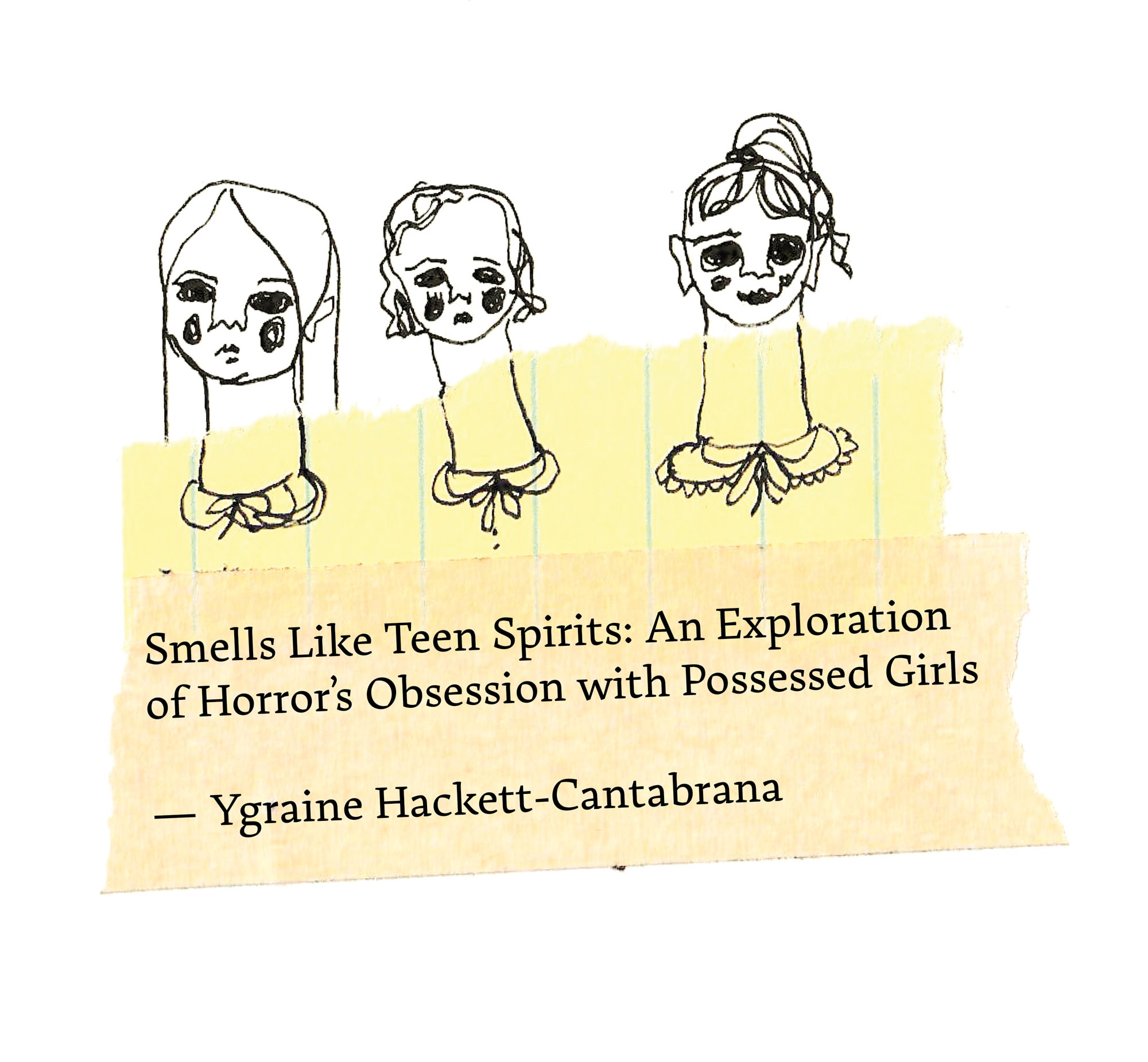Smells Like Teen Spirits: An Exploration of Horror’s Obsession with Possessed Girls

Demonic possession in horror is one of the most popular and profitable subgenres, with the boom initiated by the infamous The Exorcist (1973) directed by William Friedkin and based on the novel by William Peter Blatty. Starting with The Exorcist, there has been a steady stream of horror films following the typical tropes of the fight between good and evil: formerly innocent victims turned into head spinning, wall crawling, grotesque ghouls, yelling expletives or talking in tongues and oozing bodily fluids in all manner of crazy colours. One factor that links most possession horrors, whether they are set against the Christian belief of the Devil testing the strengths of the faithful, or a Jewish dybbuk infesting the perfect vessel, is the demographic of the possessed victims. The majority of the demonically possessed in this subgenre tend to be pre-pubescent or adolescent females.
Cases of the demonically possessed expand further back than when the phenomenon was first committed to celluloid, spanning many countries and cultures. There are stories in the bible of Jesus casting out demons, as well as exorcism being a rite of Catholicism. Islamic possession beliefs stem from creatures such as the Jinn, as well as possession lore that stems from places in Africa such as Democratic Republic of Congo, Kenya, Ethiopia and the African diasporic religions like Haitian Vodou and Hoodoo. Even Asian nations such as Japan, China, India and Malaysia all have legends, traditions and beliefs that centre around either demonic or spiritual possession. The original films that showed depictions of demonic possession and exorcism were Christian silent films that portrayed Jesus casting out demons like From The Manger To The Cross (1912) and The King Of Kings (1927) in which Mary Magdalene is exorcised of seven demons by Jesus. However The Exorcist, released in 1973 to crowds of fainting and terrified audiences, was one of the first and certainly the most pivotal and influential demonic possession horror films of all time.
The Exorcist tells the story of twelve-year-old Regan MacNeil, a formerly sweet and gentle child, who begins to exhibit increasingly bizarre and alarming behaviour after finding a ouija board. After science fails to find an explanation for the sudden change not only in her demeanour, but also her appearance, her mother Chris is forced to seek help in the form of two Jesuit priests who, through performing the rite of exorcism, attempt to cast out the demon that has taken up residence in the young girl’s body. The Exorcist was adapted from the 1971 novel of the same name written by William Peter Blatty, who also wrote the screenplay for the film. Blatty had the idea for the novel after reading a Washington Post article about the case of a possessed little boy from 1949. William Blatty swapped the gender of the demonically afflicted child and thus was born the horror trope of possessed little girls terrorising their families and anyone who dares to attempt to save them. We see this tradition continued in films such as The Exorcism of Emily Rose (2005), Jennnifer’s Body (2009), The Last Exorcism (2010), The Possession (2012), The Devil’s Doorway (2017) and more recently Prey For The Devil (2022). So what is the horror film genre’s obsession with possessed pre-pubescent and teenage girls?
Female puberty signifies a period of incredible change physically, emotionally and mentally. Internal and external changes occur, resulting in altered appearance and unseen physical transformations. Puberty can also cause a metamorphosis of personality; what was once an innocent young child, who believed and obeyed everything their parents told them, is now an individual carving out her own personality and beliefs, breaking away from the nuclear parental hold, sometimes in an oppositional manner. It is often a difficult and turbulent time for children and their parents, one that can be wrought with disagreement and dispute. In addition to the already demanding physical aspect of puberty, when the challenges of family, relationships and major life changes are added into the equation, the consequential trauma that can arise can be destructive and catastrophic to young girls. Mary Wild, a Freudian cinephile and pop psychoanalyst who is the founder of the Projections lecture series at the Freud Museum London, says that possession films in general:
“…evoke a psychological process of something non-physical (thought, memory, feeling, trauma) taking hold of the body, producing adverse undesirable effects.”
When we examine the events surrounding the victims in these films, we begin to understand the connection between the trauma and the physical and supernatural manifestation of an invading demonic force. In The Exorcist, twelve-year-old Regan is experiencing the tumultuous separation of her parents, a non-existent father and a workaholic mother. In The Exorcism of Emily Rose, based on the real-life case of Anneliese Michel, the fictional characterisation of the nineteen-year-old Emily Rose sees her leaving her devout christian home for the first time for university. Emily from The Possession is dealing with her parent’s divorce and her mother’s new relationship, the titular character of Jennifer’s Body has suffered sexual trauma, and Kathleen O’Brien from The Devil’s Doorway is a young pregnant girl, incarcerated in one of Ireland’s horrific Magdalene Laundries.
Whilst young pre-pubescent and adolescent males are not exempt from the suffering experienced by their female counterparts, they are very rarely the subject of demonic possession genre films, with the exceptions of films like A Haunting In Connecticut (2009) and The Pope’s Exorcist (2023). This may be because female behaviour or misbehaviour is viewed as more monstrous if deemed unacceptable by wider society. As well as symbolic changes in appearance, knowledge of things their parents cannot comprehend, and conflict with a set of predetermined values their parents and other authority figures have set out for them, possession horror also portrays a sexual component for the demonically-possessed female. Examples include Regan “masturbating” with a crucifix, pre-marital sex resulting in pregnancy in The Devil’s Doorway and The Last Exorcism, Jennifer’s sexual promiscuity and implied bisexuality or Emily Rose’s blossoming relationship in university in The Exorcism of Emily Rose. The possession of these girls and young women is represented as a punishment for their flourishing sexuality, as Mary Wild remarks that the demonic possession of an adolescent teenage girl can be seen as:
“… a sign of a phallocentric culture that seeks to condemn the emergence of feminine subjectivity and female sexuality. The burgeoning eroticism of women remains taboo in our societies – culturally many people still feel uncomfortable accepting female desire. So representing it as an unwanted demonic force attaching itself to a “clean virginal girl” becomes toxically reassuring; it absolves the teenage girl of the moral burden of entering sexual life imposed on her by society. She remains innocent, fighting against a totally natural physical urge to be ‘possessed.’”
Jennifer’s Body directed by Karyn Kusama and written by Diablo Cody is somewhat of a subversion of the possession trope. Megan Fox stars as Jennifer Check, a high school student who, after being wrongly thought of as a virgin, is sacrificed to Satan by a local band intent on fame and fortune. Because she is not a virgin, Jennifer becomes possessed by a demonic succubus who must feed off human blood and flesh to satiate her hunger and remain powerful. Whilst initially and at face value Jennifer may be seen to be punished for not being a virgin by being possessed, her demonic possession is what saves her life and allows her to take back a sense of power after the trauma of being kidnapped by a band and sacrificed. Bearing a striking resemblance to protagonists in rape-revenge movies, Jennifer and her demon strive to counterbalance the gendered power-play in sexuality that is usually depicted in films as being acted out by male characters. Of the filmmakers who are actively working to subvert the victimised possessed female character, Wild says:
“They are utilising the tropes of possession in horror cinema but changing narrative/symbolic conditions to centre female desire. This is a radical way to elevate the sub-genre, because it renegotiates the parameters of what gets represented. I think that filmmakers are able to change the landscape of horror to reflect real challenges we all face. Empowerment can mean rewriting the template to introduce a new set of attitudes, but it can also involve repurposing existing outdated tropes to expose their shortcomings.”
The centering of pre-pubescent and adolescent females within the demonic possession subgenre represents how society views the behaviour of the female youth, and all women, who fail to be subservient to expectations. A young girl who swears, disobeys her parents, is not perfectly presentable, and is struggling psychologically, is shocking to society, and thus becomes the ideal symbol of demonic possession in horror films. The same cannot be said of boys and young men as Mary Wild points out:
“There is a gender double standard, as teenage boys and young men are not expected to resist and combat bodily instincts; the prospect of possession in the male context is rendered structurally irrelevant.”
As the conversation surrounding women’s rights evolves, including bodily autonomy, sexual and reproductive freedom and roles within the workplace and at home, we can only hope this is reflected within the possession genre. Whereas before, bedevilled girls were helpless victims fighting against the changes happening inside them and awaiting a male saviour lest they be killed or sent to hell, it’s time for more possession horrors like Jennifer’s Body, where the demonic rebellion against a good-girl society is embraced.
Ygraine Hackett-Cantabrana is a podcaster from Ireland who hosts What A Scream, a horror movie podcast, and is a senior contributor to Moving Pictures Film Club, and a regular contributor to Ghouls Magazine. She has also written for BFI Online, Fangoria, Dread Central, Horrified Magazine and Pretty Deadly Zine. Ygraine was chosen as a participant for the BFI’s critics mentorship program as part of London Film Fest. She has a special interest in Irish horror, possession and exorcism and parenthood in horror.
Twitter: what_scream
